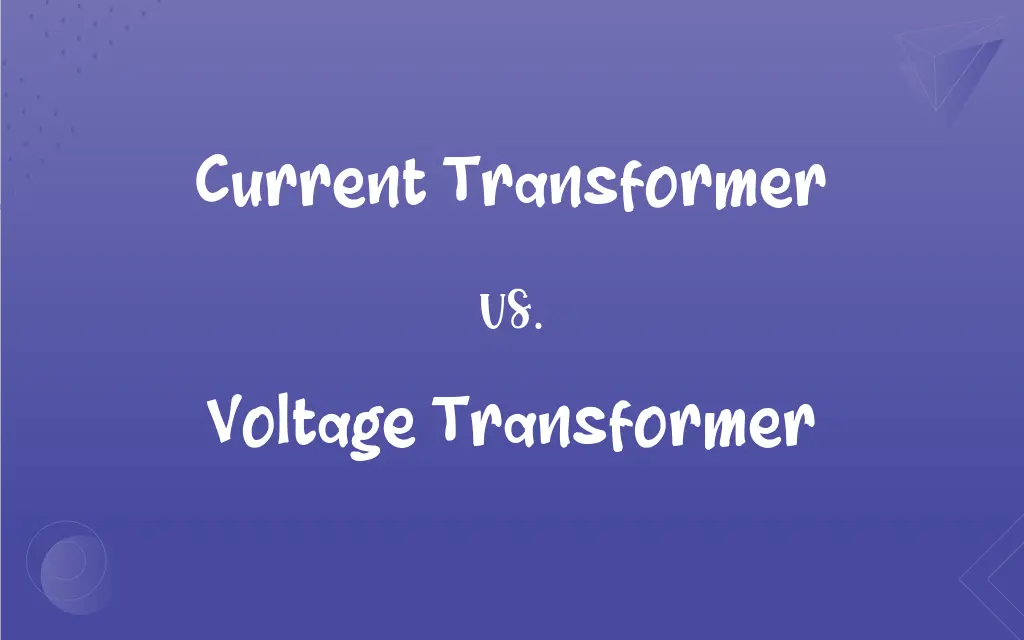Current Transformer vs. Voltage Transformer: What's the Difference?
Edited by Aimie Carlson || By Harlon Moss || Updated on October 11, 2023
Current transformers (CTs) measure electric currents, scaling them down for monitoring or protection, while voltage transformers (VTs, also called potential transformers) measure and scale down the voltage in high-voltage circuits.

Key Differences
A current transformer (CT) primarily focuses on measuring the current flowing through an electrical circuit. It serves to step down the current to a lower value, suitable for delicate measuring instruments, ensuring accurate readings without directly interfering with the primary power flow. In contrast, a voltage transformer (VT) predominantly focuses on voltage metrics within a circuit.
Voltage transformers step down the voltage levels to a safer and more measurable level for metering and protective relaying. The purpose is to ensure a proportional and phase-aligned replication of the voltage in the high-voltage circuit. Current transformers, however, mitigate the challenges of measuring high currents directly, by providing a reduced current that is proportional to the current in the circuit.
In the realm of protection, the current transformer emerges as a crucial component. It provides a method to safely monitor the actual current flowing through a system, facilitating the actuation of protection mechanisms when irregularities arise. Voltage transformers, while also involved in protection mechanisms, tend to lean more towards precise metering applications.
The design intricacies between the two transformers also create divergence. Current transformers often necessitate accommodation for large currents and are constructed accordingly, ensuring minimal internal phase shift and precise representation of primary currents. Voltage transformers, however, prioritize maintaining accuracy in voltage representation across a spectrum of applied voltages, which dictates their design and operational parameters.
Despite their differences, current transformers and voltage transformers are harmoniously utilized within electrical systems, each contributing uniquely to system monitoring and protection. Through their individual functionalities, they facilitate safer and more manageable interactions with high-power electrical systems, allowing for efficient power distribution while safeguarding connected equipment and circuits.
ADVERTISEMENT
Comparison Chart
Primary Function
Measures and scales down currents.
Measures and scales down voltages.
Usage
More focused on protection relay.
Widely used for metering and protection.
Measurement Aspect
Monitors current in the circuit.
Monitors voltage in the circuit.
Connection
Connected in series with the circuit.
Connected in parallel with the circuit.
Secondary Circuit Type
Usually a short circuit.
Open circuit or simply connected to meters.
ADVERTISEMENT
Current Transformer and Voltage Transformer Definitions
Current Transformer
Current transformers enable indirect measurement of high currents, facilitating accurate system monitoring.
Through using a current transformer, technicians could accurately gauge circuit currents without directly tapping into high-amperage flows.
Voltage Transformer
Voltage transformers isolate the measurement instruments from the high-voltage power circuits.
To protect the delicate measuring devices, a voltage transformer was utilized to isolate them from the primary high-voltage circuit.
Current Transformer
It isolates measurement instruments and protection relays from high-voltage power circuits.
Engineers utilized a current transformer to protect delicate relay systems from direct exposure to the primary power flow.
Voltage Transformer
They permit precise monitoring and control by providing a manageable voltage level to meters and relays.
With the voltage transformer supplying a scaled-down voltage, operators could meticulously monitor and control the electrical system.
Current Transformer
Current transformers create a secondary current that is precisely proportional to the primary circuit current.
The current transformer generated a 5 A secondary current, accurately representing the 500 A primary flow.
Voltage Transformer
It creates a scaled-down, phase-aligned replica of the voltage in the high-voltage circuit.
By generating a proportionate, smaller voltage, the voltage transformer facilitated precise voltage measurements in the high-voltage circuit.
Current Transformer
They're pivotal for operational safety, preventing high currents from reaching sensitive monitoring instruments.
The current transformer ensured operational safety by providing a low-amperage replica of the circuit current for monitoring.
Voltage Transformer
A voltage transformer reduces high voltages to a safe level for metering applications.
The voltage transformer was employed to provide a low-voltage replica for accurate metering without risk.
Current Transformer
A current transformer scales high primary currents to manageable levels for meters or relays.
The current transformer was installed to safeguard the meters from high currents by reducing them to readable levels.
Voltage Transformer
Voltage transformers are crucial for accurately measuring and protecting systems from voltage anomalies.
The voltage transformer promptly detected a surge, activating protective relays and safeguarding the electrical system.
FAQs
What is the primary function of a current transformer?
CT scales down high currents to manageable levels for safe measurement and protection.
Can a CT be utilized for metering purposes?
Yes, CTs can be used for both protection and metering of electrical circuits.
How does a voltage transformer differ in function?
VT steps down high voltages and provides isolation for metering and protection devices.
Is accuracy an essential factor for CTs?
Yes, CT accuracy is crucial to ensure precise current measurements and to enable reliable protection.
How is a current transformer connected in a circuit?
CT is connected in series with the circuit being monitored.
Is a voltage transformer essential for protective relay systems?
Yes, VTs provide scaled-down voltages that enable protective relay operations without exposing them to high voltages.
What happens if a CT secondary circuit is opened?
Opening a CT secondary circuit can be dangerous, causing high voltages that may damage equipment and pose safety risks.
How precise is the voltage replica created by a VT?
VTs create a highly accurate, phase-aligned, scaled-down replica of the primary voltage.
Can CTs be used in low-voltage applications?
Yes, CTs can be used in any application where current needs to be measured or monitored, regardless of the voltage level.
What are the core materials used in CT manufacturing?
CT cores are typically made of silicon steel or amorphous steel.
What are the potential issues if a CT malfunctions?
A malfunctioning CT can provide inaccurate current readings, impairing protective relay operation and risking equipment damage.
How is a voltage transformer connected?
VT is connected in parallel with the circuit.
How are VTs classified based on their application?
VTs are classified as metering, protective, or station service transformers based on their specific application.
What safety measures are inherent to VTs?
VTs inherently provide isolation between high-voltage power circuits and metering or protection devices, ensuring safety.
How does a VT handle voltage surges or spikes?
VTs, especially those utilized for protection, are designed to manage and safely transmit useful data during voltage surges, ensuring protective systems are triggered.
Can VTs be utilized in high-voltage testing?
Yes, VTs can be used to safely test and measure high-voltage equipment by providing a lower voltage output.
Can CTs and VTs be utilized concurrently?
Yes, CTs and VTs often work in tandem in electrical systems for comprehensive monitoring and protection.
What role does a VT play in a metering setup?
VT provides accurate, scaled-down voltage to metering devices, ensuring safe and precise readings.
Do VTs play a role in power quality monitoring?
Absolutely, VTs are integral for monitoring power quality by providing accurate voltage readings.
Are there physical size limitations for CTs?
CTs can range significantly in size based on the application and current rating.
About Author
Written by
Harlon MossHarlon is a seasoned quality moderator and accomplished content writer for Difference Wiki. An alumnus of the prestigious University of California, he earned his degree in Computer Science. Leveraging his academic background, Harlon brings a meticulous and informed perspective to his work, ensuring content accuracy and excellence.
Edited by
Aimie CarlsonAimie Carlson, holding a master's degree in English literature, is a fervent English language enthusiast. She lends her writing talents to Difference Wiki, a prominent website that specializes in comparisons, offering readers insightful analyses that both captivate and inform.
































































